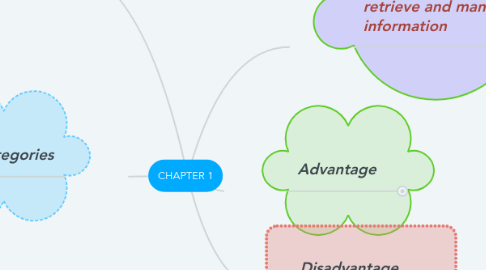
1. Applications
1.1. education
1.1.1. Learning Management System : students can get their lecture note and submit assignment
1.2. finance
1.2.1. online banking : to pay bills and check balance . exp: ASB
1.3. government
1.3.1. HRMIS : online system for updating government employee information
1.4. health care
1.4.1. medline ; many website provide up-to-date medical fitness, nutrition or exercise information
1.5. science
1.5.1. virtual reality : use of computer to imagined environment that appears as 3D space
1.6. publishing
1.6.1. online newspaper and online magazine : allow user to get information easily by reading newspaper and magazine online
1.7. travel
1.7.1. Global Positioning System (GPS) : helps users to track routes for specific location
1.8. manufacturing
1.8.1. Computer Aided Manufacturing : controls machine tools, mainly robot arms to speed up and improve of the process for task
2. Categories
2.1. supercomputer
2.1.1. fastest and most pawerful computer
2.1.2. capable to process mote than one quadrillion instructions in a single second
2.1.3. size : occupy a full room of equipment
2.1.4. speed : tens of thousand of processors
2.1.5. storage : extremely large - 3.1 PB
2.2. mainframe
2.2.1. large, expensive, powerful computer
2.2.2. can handle hundreds or thousands of connected user simultaneously
2.2.3. size : occupy partial room to a full room of equipment
2.2.4. speed: dozen of processors
2.2.5. storage: very large & addable - 4.6 TB
2.3. personal computer
2.3.1. a computer that can perform all of its input, processing, output and storage activity by itself
2.3.2. size: fits on the desk
2.3.3. speed: single processor
2.3.4. storage: large - 500 GB
2.4. mobile computer
2.4.1. personal computer you can carry from place to place
2.4.2. eg: notebook computers, laptop computers, netbook, tablet pc
2.4.3. size: fits on your lap or in hand
2.5. mobile device
2.5.1. computing device small enough to hold in your hand
2.5.2. eg: smart phone, e-book reader, digital camera
2.5.3. size: fits in the palm of your hand or a in pocket
2.6. embedded computer
2.6.1. special purpose computer that is function as a component in a large product
2.6.2. eg: anti lock brakers, airbag controller, printers, digital television
2.6.3. size: miniature. it is mounted on a circuit board and then installed in a machine using wires to carry input and output signals
3. Definition: the use of computer, hardware and software to store, retrieve and manipulate information
4. Advantage
4.1. speed
4.1.1. can process billions or trillions of operation in a single second
4.2. reliability
4.2.1. electronic components in computer are dependable because they rarely to break
4.3. consistency
4.3.1. computer with same input will produce the same results consistently
4.4. communication
4.4.1. computer can communicate wirelessly with other computer
4.5. storage
4.5.1. computers can store large amounts of data
5. Disadvantage
5.1. violation of privacy
5.1.1. other person might steal our personal records if they were not protected
5.2. public safety
5.2.1. we might be a victim to crime if we are sharing out photos publicly
5.3. impact on labour force
5.3.1. employee might jobless if their skills have been replaced by computers
5.4. health risk
5.4.1. prolonged computer use can lead to health injuries
5.5. impact on environment
5.5.1. computer manufacturing process and computer waste can cause pollution

